Droopy Boom Syndrome - Set up for accurate application

Syngenta Application Specialist, Tom Robinson, explains what to look for and what steps to take before the sprayer gets out on the pitch or golf course
Any turf spray treatment, for nutrition, disease control or growth regulation, is only ever as good as the accuracy with which it is applied.
Sprayer set up is the first stage in hitting the intended target and achieving desired consistent coverage. Firstly, undertake a good visual check all round the sprayer. Make sure nothing has been bent or broken whilst it has been stored in the shed; it is certainly not unheard of for nozzle units to have been bent or broken off.
If the machine is dirty or dusty, give it a wash off prior to checking its condition. Washing should ideally be in a designated filling area and any run off collected for safe disposal, in case there were any spray residues on the outside of the tank. Otherwise, wash on a safe area of ground where washings will not run into a water course or drainage ditch.

It is worth checking that, when the booms are folded, no hoses are under tension, which could put extra strain on connection clips and lead to leaks.
The next step is to check that the tyre pressures are correct and even. Ideally, the pressure wants to be operating as low as the tyre manufacturer permits for the weight of sprayer being carried (when full). Most importantly, the pressure must be exactly equal on each side, especially the rear tyres. This can make a really significant impact on achieving a level boom.
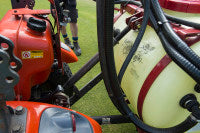
Looking from the side of the tractor, and with the central nozzles at 50cm height from the ground, check that the sprayer is vertical. If a sprayer is tilted backwards, it will put more spray on the front of the leaf, in the direction of travel, or vice-versa if leaning forward. Adjust the tractor top-link to put the sprayer in the right position. If the sprayer is mounted on a Gator or ATV carrier machine, the mounting frame may require adjustment.
Now check that the boom is absolutely level all the way across. In too many instances, we see 'droopy boom syndrome' - where one or both boom sections drop at the end. This may require mechanical adjustment or refurbishment of bushes and suspension systems to correct, but is essential to get an even spray pattern.
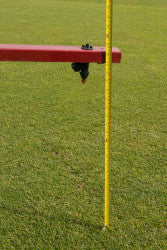
Whilst doing this, just confirm that the distance being measured is the ground to nozzle tip, not the actual boom height. In practice, the nozzles can sit up to 10cm or more below the boom height. Whilst the Syngenta XC Nozzle has been designed to cope effectively with undulations and variability in height whilst maintaining an even spray coverage, the best results are still achieved from accurately setting up at the optimum 50cm height.
Make these checks with the tractor running and the hydraulic system powered-up, otherwise, when it is switched off, the sprayer tends to sink and would give an incorrect measurement compared to when working.
Now we need to look at the operation of the sprayer. Fill the tank at least half full with clean water and, in the designated sprayer-testing or cleaning area, switch on the nozzles and high pressure test to at least five bar output. Visually check all the hoses and joints for any signs of leaks.
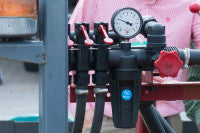
To rectify this, take off the valve cap and, using a bicycle or car-tyre pump, put in the same pressure that you would be working at - typically three bar. The needle on the gauge should now remain steady. If not, there may be another mechanical fault that needs addressing by an engineer.
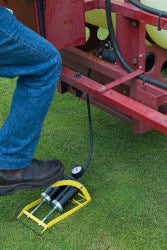
Turning attention to the nozzles; with the sprayer switched on, check that the pattern from each nozzle looks even and consistent. Small particles of grit can give a streaky effect to the pattern. Flat fan nozzles are notoriously susceptible to these partial or full blockages, where the shape of the orifice gives narrow pinch points that can collect debris. The Syngenta XC Nozzle, however, has been designed with a more open orifice which means that any blockages are extremely rare, especially with the 04 or 08 sizes.
Also, take the nozzles out and visually check any filter that is in place. Where iron or trace elements have been regularly sprayed, as is frequently the case on sports turf, fine filters can be blocked with residues that interrupt even flow. Poorly formulated liquid fertilisers can also prove problematic. Our nozzle design facilitates the use of a larger 50 mesh wire filter (usually identified with a red plastic insert), compared to the finer 100 mesh (blue insert) filter typically fitted with standard turf sprayer nozzles. I do suggest to always fit wire gauze filters, which are far more effective than the predominantly solid metal filters with slots that are sometimes used.
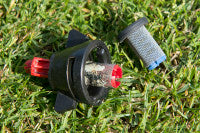
I am often asked how long a set of nozzles should last, but it is entirely dependent on how much spraying is done and, more to the point, what has been applied. Syngenta fungicides or Primo Maxx, for example, are formulated with fine particles for fast turf uptake and so create very limited nozzle wear, whereas a generic coarse soluble iron could cause far greater abrasion and rapid wear. Once the shape of the orifice has been distorted, any wear can be exacerbated and can rapidly deteriorate.
To do the test, set the sprayer to working pressure, and then use a measuring cylinder to collect the output from an individual nozzle for exactly 30-seconds. Note down the volume and repeat for each nozzle. Calculate the average output per nozzle, and then look to see if any individual nozzle was more than 5% different to the average. If it was, then the nozzles would be unacceptably worn and the whole set must be replaced.

PitchFocus was organised by Everris and Syngenta at the Leeds Headingley Stadium, in association with Bernhard Grinders; Campey Turf Care Systems; EnvironMonitors and Lely/Toro. With special thanks to Leeds Rugby Head Groundsman, Ryan Golding and Headingley Cricket Head Groundsman, Andy Fogarty
Tom's Top 10 Tips to check - before spraying
• Tyre pressures are equal
• Boom is level and nozzle bodies vertical
• Nozzle tips are 50cm from the ground
• Pipes are sound
• No leaks under high pressure test
• Pressure gauge needle is steady
• Pressure is equal on all boom sections
• Filters are clean
• Nozzle pattern is correct
• Nozzles are not worn

"It really highlighted that spending just a few minutes checking the sprayer before any application can make a real difference in the accuracy of results - and hopefully ensure that we get the very best from every treatment," he reported.
"We are aiming to be far more precise with the Everris-led nutrition programme, including liquid feeds to keep the turf in good health through the extended playing season, but avoid wasteful over-application; accurate spraying is crucial to get that right."
"With timeliness also important for proactive disease control applications and Primo Maxx programmes, the tips we have learned from the sprayer set-up session will certainly further help."
"Having seen it in practice, it is not that difficult and something that we can beneficially build into the routine."
